A cancer diagnosis provokes a sea of emotions, fear and anxiety over the future foremost. However, being diagnosed with a common cancer such as breast or prostate cancer has a hard-won comfort zone, in that both patients and physicians are armed with a plethora of data and resources on how to treat and survive those diseases. Moreover, a patient can execute a quick Google search and readily find others who are in the same clinical boat; support groups abound. But where does a patient diagnosed with Merkel cell carcinoma turn? For that matter, how much knowledge does his or her local community oncologist have about such an uncommon cancer?
BOOKMARK

Title: Textbook of Uncommon Cancer, 5th Edition
Editors: Derek Raghavan, Manmeet S. Ahluwalia, Charles D. Blanke, Jubilee Brown, Edward S. Kim, Gregory H. Reaman, and Mikkael A. Sekeres
Publisher: Wiley-Blackwell
Publication date: May 2017
Price: $400.00, hardcover, 1,296 pages
These problematic clinical issues and more are thoroughly fleshed out in the recently published Fifth Edition of the Textbook of Uncommon Cancer. Under the editorial stewardship of 7 esteemed leaders in oncology, the textbook is organized into 13 sections—each thoroughly elucidated by contributors who are leaders in treating their specific uncommon cancers. A sentence in the Preface speaks volumes about the challenge they faced when the first seed of collaboration was planted some 30 years ago: “Although there remains a paucity of level 1 trial data (on uncommon cancer), because of small patient numbers and partly because of a lack of structured interest in collaborative research in these domains, the amount of available information has begun to increase.” To that end, the Textbook of Uncommon Cancer offers a valuable resource for the oncology community, from the office of a community doctor to the shelves of an academic library.
Straightforward, Uncluttered Prose
From the opening pages, the thoroughly referenced textbook is well organized and, considering the heady scientific content, is written in straightforward, uncluttered prose. Each section’s succinct introduction may encompass an historical background or precede a separate history of the disease. The figures and tables are clear and situated in content-complementary format. Moreover, the treatment algorithms are equally clear and clinician-friendly.
After eight exhaustive but necessary pages of abbreviations, section 1 on General Principles of Care of Uncommon Cancers opens with an elegant chapter titled “A Structured Approach to Uncommon Cancers,” by Derek Raghavan, President, Levine Cancer Institute, Carolinas HealthCare System, Charlotte, North Carolina. In his introduction, Dr. Raghavan points out there is no clear consensus on what constitutes a rare cancer, although the commonly accepted definition is in the range of 6 to 15 new cases per 100,000 population per year, which does not include the rare subtypes of common cancers. He further notes that although cancers of the prostate and bladder are common, their small cell variants are definitively rare.
From Diagnosis Onward
Precise definition aside, Dr. Raghavan stresses there is remarkably little definitive information about the diagnosis and management of uncommon cancers. He then guides the reader through the necessary steps to take from the point of diagnosis of an uncommon cancer onward.
The opening chapter sets the stage for the two that follow, both of which offer spot-on information about what a patient needs to know when diagnosed with a rare cancer and how the public can play a role in shaping a research model directed at rare cancers. This is simply terrific value-added content, rarely seen in clinical cancer textbooks. For instance, chapter 2 provides a rundown on information needs and sources, both sections portioned in numbered paragraphs that tightly frame each subject. Given the dearth of reliable information on uncommon cancers, these two chapters could easily be published as a resource guide for community physicians.
As expected, when discussing unusually rare cancers in which data on disease management are scarce, the sections on treatment are relatively brief. However, the authors skillfully address this by aggregating experiences cited in the medical literature and, when possible, offer substantiated opinions for the best treatment approach.
The Textbook for Uncommon Cancer tackles the most difficult clinical scenarios faced by today’s oncology specialists. By structuring this complicated clinical information according to organ systems, from epidemiology, genetics, clinical presentation, imaging, pathology, staging, prognosis, and treatment, replete with clearly drawn tables and figures, the authors have provided a high-value resource to help guide physicians in the treatment of these uncommon cancers. This textbook is highly recommended for The ASCO Post readership. ■

